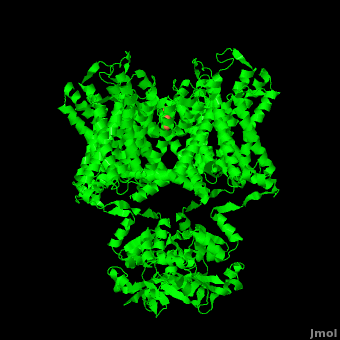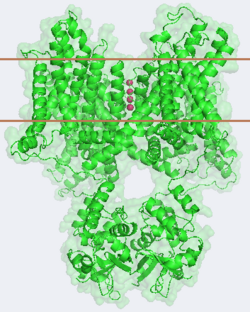Potassium Channel
From Proteopedia
| Line 78: | Line 78: | ||
**[[4jta]], [[4jtc]], [[4jtd]] - rKCh Kv1.2-2.1 + KCh toxin <br /> | **[[4jta]], [[4jtc]], [[4jtd]] - rKCh Kv1.2-2.1 + KCh toxin <br /> | ||
**[[2r9r]] - rKCh<br /> | **[[2r9r]] - rKCh<br /> | ||
| - | **[[1qx7]] – rKCh SKCa+ calmodulin<br /> | ||
| - | **[[1g4y]] – rKCh rSK2 calmodulin binding domain SKCa + calmodulin<br /> | ||
**[[1exb]] - rKCh Kv1.1 T1 domain + KV beta2 protein<br /> | **[[1exb]] - rKCh Kv1.1 T1 domain + KV beta2 protein<br /> | ||
**[[2p7t]] - rKCh + FAV<br /> | **[[2p7t]] - rKCh + FAV<br /> | ||
| Line 155: | Line 153: | ||
**[[1kkd]] – rKCh calmodulin-binding domain - NMR - rat<br /> | **[[1kkd]] – rKCh calmodulin-binding domain - NMR - rat<br /> | ||
| - | **[[3sjq]], [[4g27]], [[4g28]], [[4j9y]], [[4j9z]] - rKCh calmodulin-binding domain + calmodulin<br /> | + | **[[3sjq]], [[4g27]], [[4g28]], [[4j9y]], [[4j9z]], [[1g4y]] - rKCh calmodulin-binding domain + calmodulin<br /> |
| + | **[[1qx7]] – rKCh SK2 gating domain + calmodulin<br /> | ||
**[[2pnv]] – rKCh leucine zipper domain SKCa | **[[2pnv]] – rKCh leucine zipper domain SKCa | ||
Revision as of 09:33, 12 July 2015
| |||||||||||
Contents |
Page Development
This article was developed based on lectures given in Chemistry 543 by Prof. Clarence E. Schutt at Princeton University.
Potassium channels (KCh) are subdivided into voltage-gated KCh and calcium-dependent KCh. The latter are subdivided into high- (BK, LKCa), intermediate- and small-conductance KCh (human SK1, rat SK2, SKCa). The T1 domain is a highly conserved N-terminal domain which is responsible for driving the tetramerization of the KCh α subunit. The inward rectifier KCh (IRK) passes current more easily in the inward direction. MthK is a calcium-dependent KCh from Methanobacterium thermoautrophicum.
3D structures of Potassium Channels
Updated on 12-July-2015
Additional Resources
References
- ↑ 1.0 1.1 Zhou Y, Morais-Cabral JH, Kaufman A, MacKinnon R. Chemistry of ion coordination and hydration revealed by a K+ channel-Fab complex at 2.0 A resolution. Nature. 2001 Nov 1;414(6859):43-8. PMID:11689936 doi:http://dx.doi.org/10.1038/35102009
- ↑ 2.0 2.1 2.2 2.3 Doyle DA, Morais Cabral J, Pfuetzner RA, Kuo A, Gulbis JM, Cohen SL, Chait BT, MacKinnon R. The structure of the potassium channel: molecular basis of K+ conduction and selectivity. Science. 1998 Apr 3;280(5360):69-77. PMID:9525859
- ↑ Jiang Y, Lee A, Chen J, Ruta V, Cadene M, Chait BT, MacKinnon R. X-ray structure of a voltage-dependent K+ channel. Nature. 2003 May 1;423(6935):33-41. PMID:12721618 doi:http://dx.doi.org/10.1038/nature01580
- ↑ Waters MF, Minassian NA, Stevanin G, Figueroa KP, Bannister JP, Nolte D, Mock AF, Evidente VG, Fee DB, Muller U, Durr A, Brice A, Papazian DM, Pulst SM. Mutations in voltage-gated potassium channel KCNC3 cause degenerative and developmental central nervous system phenotypes. Nat Genet. 2006 Apr;38(4):447-51. Epub 2006 Feb 26. PMID:16501573 doi:ng1758
- ↑ 5.0 5.1 5.2 5.3 Long SB, Tao X, Campbell EB, MacKinnon R. Atomic structure of a voltage-dependent K+ channel in a lipid membrane-like environment. Nature. 2007 Nov 15;450(7168):376-82. PMID:18004376 doi:http://dx.doi.org/10.1038/nature06265
Proteopedia Page Contributors and Editors (what is this?)
Michal Harel, David Canner, Joel L. Sussman, Alexander Berchansky, Ann Taylor


